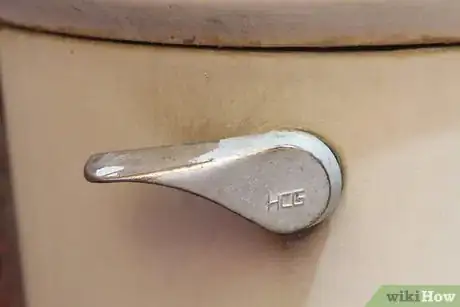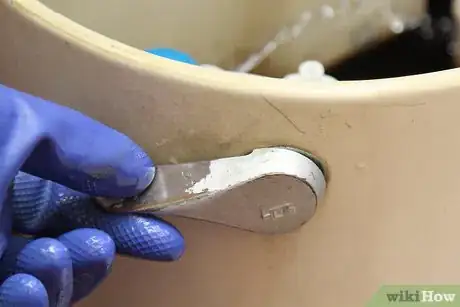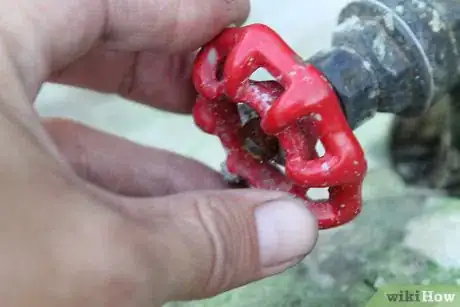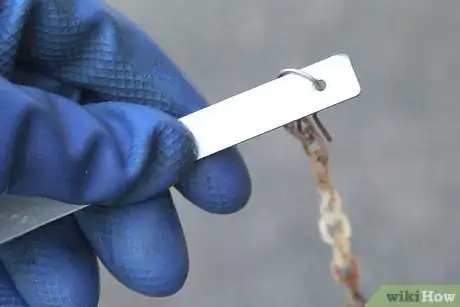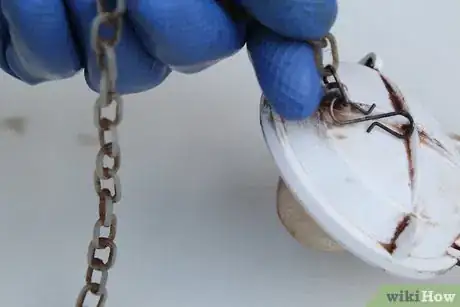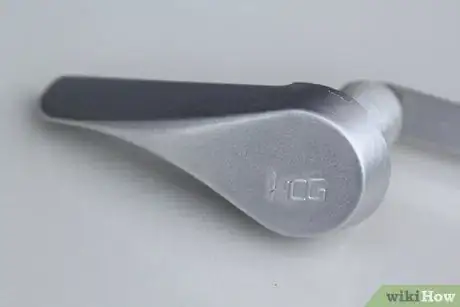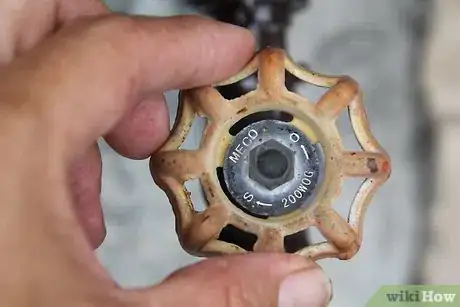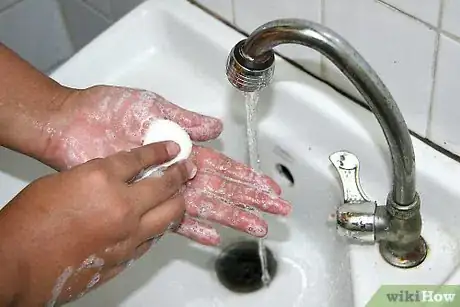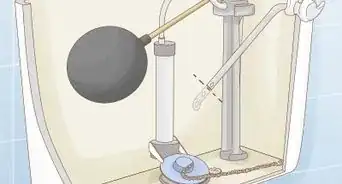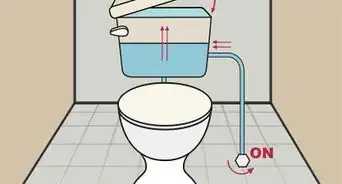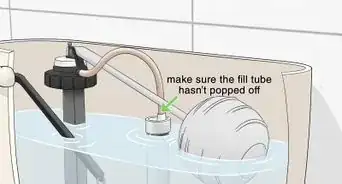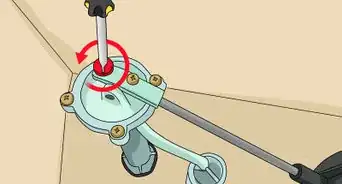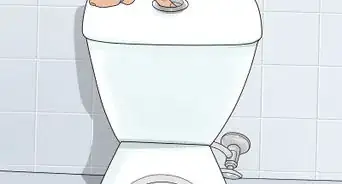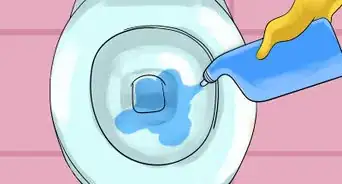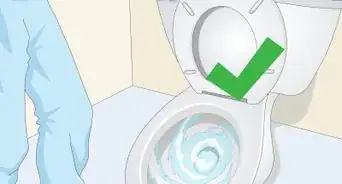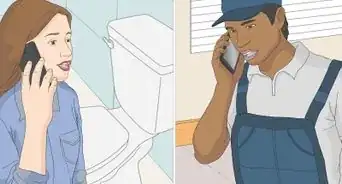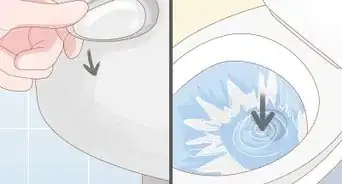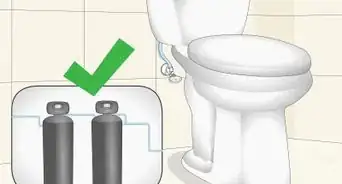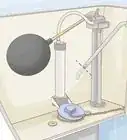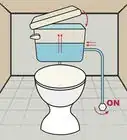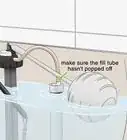This article was co-authored by Dave Jones. Dave Jones is a Professional Plumber and the Midwest Regional Vice President at Roto-Rooter Plumbing & Water Cleanup. In 1992, Jones joined Roto-Rooter as a drain service technician at the age of 18. Since then, he has risen through the ranks into positions of increasing authority. Dave served as general manager of Roto-Rooter’s Charlotte, North Carolina, and Atlanta, Georgia branches before being promoted to Contractor Area Manager and later to Regional Vice President. Dave holds Master Plumber Licenses in Pennsylvania, North Carolina, and Georgia.
This article has been viewed 107,358 times.
To most toilet-users, the toilet's handle is one of the few parts that they will directly interact with, perhaps second only to the toilet's lid and seat, which seems to be less appreciated and utilized by men, often to their spouse's dismay. This crucial mechanism, also known as the 'flush handle', serves a humble but crucial role in the rather unexpectedly complex system that is housed within the average homeowner's flushing gravity toilet: It is the effort arm of the flush lever, the part that releases the flushing water from the tank, to the bowl, and down the output pipe leading to the sewer, septic tank, neighbor's swimming pool, etc. The point is, the toilet handle allows people to move their bodily waste far away from themselves and others without having to risk coming in contact with it. However, there's more than just one type of toilet handle, and each will require a different touch in order to keep your porcelain throne in top shape.
Steps
-
1Look at the bigger picture. The flush handle is just one part of the system called the 'flush mechanism', which allows water to flow from the tank to the bowl in a way that creates a flush. Problems that you notice in the handle are often due to a part else where in the mechanism, so its important to know how they all fit together. So go ahead and carefully remove the tank lid and peek in. There are 5 parts that make up the flush mechanism for you to identify.[1]
- The Flush Handle is what you push down on to create a flush. It is the effort arm of the flush lever.
- The Trip Lever is the bar inside the tank, and attached to the Flush Handle. Pushing down on the handle makes the Trip Lever pull up on Flapper Chain. It is the load arm of the flush lever.
- The Flush Lever Nut is the lock nut inside the tank that holds the Flush Lever in place where it enters the tank.
- The Flapper Chain is the chain that connects the Trip Lever to the Flapper. When the Trip Lever is raised, the chain allows it to pull on the Flapper.
- The Flapper is the part covering the Flapper Valve near the bottom of the tank. It is pulled up by the Trip Lever to let just enough water flow through the valve.
-
2Examine your flush handle. The problem you feel or see in the handle is very rarely a problem with the handle itself. Look at how your handle sticks out of the tank. If it looks too far in or out, or if it is wobbly, you might either have the wrong type of flush lever or a loose flush lever nut. The handle will be mounted one of six ways: on the front, side, or corner of the tank, and may be on the left or right side. If your flush lever seems to fit incorrectly, check the Handle product name or number online to see if it is compatible with your mount and tank type.[2]Advertisement
-
3Examine the flush lever nut. Grasp the lock nut with your hand, and, from your perspective, turn it clockwise, from your left to your right, until it feels tight. This will keep your flush lever from becoming wobbly, which could cause an incomplete flush. If it is broken or stripped, it will have to be replaced.
-
4Shut off the water supply. This may seem like common knowledge to some, but every plumber has forgotten this step at least once. Find the water shutoff valve, which is the almost always near the floor to the left of the toilet when you are facing it. Turn its head clockwise, from left to right, until it stops to shut off water supply to the toilet.[3]
-
5Drain the water. Now that the water supply is off, no more water should flow in to refill your tank. Press on the flush handle to let most of the water out into the bowl. There will be some left in the bottom of the tank however, as the flapper valve is not on the floor of the tank. You can remove this water by soaking it up with sponges or towels, or by using a siphon of some sort. You now have full access to your tank system and a decreased risk of soaking your bathroom.[4]
-
6Examine the flapper chain. There are a few types of flapper chains, but they all serve the same basic function. Make sure that it is connected to flapper and trip lever, it is not broken, and none of its links are bent out of shape. If the links have been bent, try to bend them back carefully with needle nose pliers. If it has simply come disconnected, find the hook or closing loop connector on the ends. Connect the more angled hook or the closing loop to one of the holes in the Lever, and the other end to the loop on the flapper. Move the Lever connector to different holes until you get as close as possible to about a half inch, or 1.27 cm, of slack. If the flapper chain has a flapper chain float, make sure its attached to the chain by the circle clips on either side of it. Adjust it closer to the flapper to gradually increase the size and duration of the flush it they are normally to short or weak.[5]
-
7Examine the trip lever. Make sure the lever is not notably too long, broken, or bent up and down. Some Trip Levers are meant to be trimmed down or bent horizontally in order to fit effectively in different types of tanks. If it is metal and bent, try to bend it back with a pair of pliers or an adjustable wrench. If it is plastic and too long, you can try to trim it down with a hacksaw. If, while the Lever is at rest, the chain is taught still, attempt to bend the Lever closer or you must replace the lever or chain. Push the Handle down and watch how the rising of the Lever affects the chain and flapper. The chain should start slightly slack, and become taught after the lever raises approximately a half of an inch. After that, the flapper should raise with the lever.[6]
-
8Examine the flapper. If, by this time, you are still having an issue with water level, refill speed, flush size, or the chain not moving, the problem, if it lies within the flush mechanism, will most certainly lie within the Flapper. There are a multitude of Flappers, but they all end up with the same problems and require the same fix. If the tank water level is constantly low, takes a very long time to refill, or flushes are incomplete, your flapper might be leaking. If the these problems occur when the chain is slack and the flapper is at rest, you should first examine and adjust the refill mechanism for the long refills and low tank water level, but replace the flapper is they persist.[7]
-
9Buy and install replacement parts. Make sure you check new parts for compatibility within the remaining parts and toilet. There may be parts that classify as 'OEM', standing for 'Original Equipment Manufacturer' and 'will-fit'. If it is an OEM, it means that the toilet company for one toilet brand decided to have it incorporated with an existing part from a part manager under the toilet company's brand. If it is will-fit, the company of that brand made that product specifically for that brand of toilet. This means that you can find OEM parts to be almost identical and cheaper than the will-fit parts. However, the will-fit parts sometimes out perform the OEM part. If you have a choice, decide upon which would be best.[8]
-
10Turn the water supply on. Now that you have successfully adjusted and improved your flush system, its time to allow the water to flow through it once again.
-
11Wash your hands. Toilets aren't clean, you know?
Community Q&A
-
QuestionHow can I increase the travel of the lever to lift the flapper higher so that water flushes faster?
 Community AnswerYou want the chain slightly slacked in a hole that's as far to the end as it will reach. This will use the highest part of the lever. However, your toilet's design is all that determines how fast and how much water rushes into the bowl. Consider getting a new toilet with increased tank and bowl outlets.
Community AnswerYou want the chain slightly slacked in a hole that's as far to the end as it will reach. This will use the highest part of the lever. However, your toilet's design is all that determines how fast and how much water rushes into the bowl. Consider getting a new toilet with increased tank and bowl outlets. -
QuestionWhat do I adjust if the flapper closes too quickly and I have to hold the handle down to get a complete flush?
 Community AnswerYou can buy different flappers that close slower, or a flapper with an adjustment for the float rate.
Community AnswerYou can buy different flappers that close slower, or a flapper with an adjustment for the float rate. -
QuestionWhat if the flush handle is sticking on the toilet seat?
 Community AnswerGet a new and smaller seat or get a smaller or thinner handle. Bad toilet design is inexcusable in this century. Your only other option, if those aren't options or don't work, is to replace the toilet.
Community AnswerGet a new and smaller seat or get a smaller or thinner handle. Bad toilet design is inexcusable in this century. Your only other option, if those aren't options or don't work, is to replace the toilet.
Warnings
- Move the tank lid with care, as they are quite expensive and can break easily.⧼thumbs_response⧽
- I know that DIY is your style, but please search for other ways to make a siphon for the leftover tank water that don't include the risk of swallowing it.⧼thumbs_response⧽
- Be gentle with the Flush Handle Nut, as its threading is reversed, and it is usually made of a softer plastic that is known to occasionally break or strip if you use a tool.⧼thumbs_response⧽
- If you are using or are planning to use a tank cleaner, check to make sure that it will not corrode your parts.⧼thumbs_response⧽
- Avoid using tools upon plastic pieces of the toilet, as the plastic is often cheap and brittle⧼thumbs_response⧽
- Do not turn the water supply back on if you have removed the Fill Valve or Fill Valve Cap, as the water can then enter the tank fast enough to create a toilet fountain.⧼thumbs_response⧽
- Do not try to bend a plastic Trip Lever, or saw a metal Trip Lever.⧼thumbs_response⧽
Things You'll Need
- Absorbent Towels or Sponges
- Any type of Siphon
- Needle Nose Pliers
- Regular Pliers
- Adjustable Wrench
- Hacksaw
- Antibacterial Soap
References
- ↑ https://www.youtube.com/watch?v=Y7TkKuSbKdM
- ↑ https://womenyoushouldknow.net/fix-friday-toilet-handle-fix-replace-tighten/
- ↑ https://homerepairgeek.com/toilet-repair/fix-toilet-handle.html
- ↑ https://www.home-repair-central.com/repairing-toilet-tank-levers.html
- ↑ https://www.youtube.com/watch?v=DVgzvqUR7q8
- ↑ https://www.popularmechanics.com/home/how-to/a4117/4303948/
- ↑ https://www.popularmechanics.com/home/how-to/a4117/4303948/
- ↑ https://www.popularmechanics.com/home/how-to/a4117/4303948/
